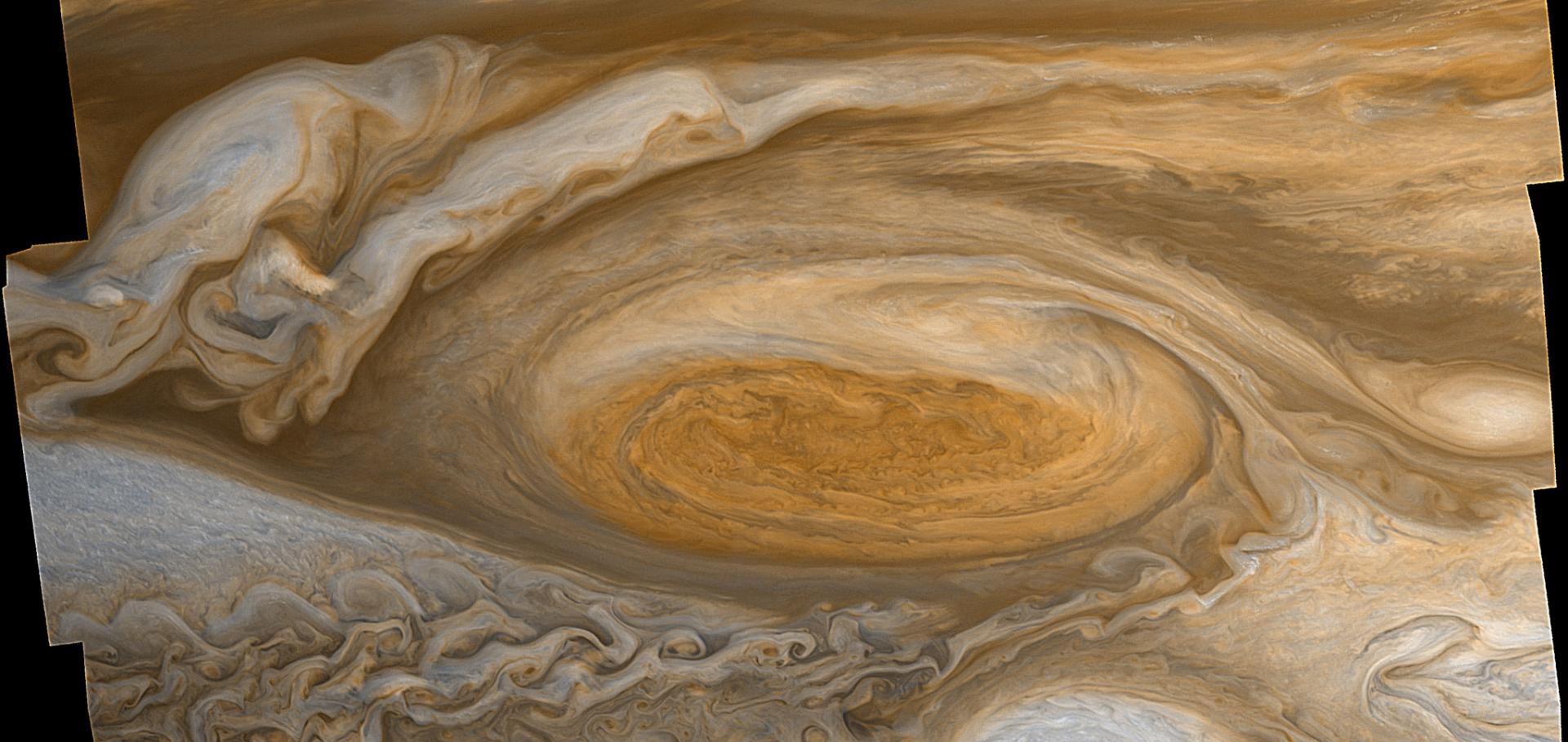Cassini Saturn polar velocity fields
University of Oxford (2021)
Abstract:
The data comprise two 2-dimensional gridded maps of horizontal wind measurements covering the north and south polar regions of Saturn, as previously published by Antuñano et al. (2015). As fully described in that paper, these measurements were derived from sets of Cassini Orbiter Imaging Sub-System (ISS) Wide Angle Camera (WAC) and Narrow Angle Camera (NAC) images using the continuum band CB2 and CB3 filters, acquired for the northern hemisphere in June 2013 and for the southern hemisphere using WAC CB2 and CB3 images taken in October 2006 and December 2008. Additional NAC images using the CB2 and red filters taken in July 2008 were also used to analyse the southern polar vortex. The WAC images covered a region extending from a planetocentric latitude of around 60-65 degrees to each pole (apart from a segment in longitude between around 35 - 110 degrees W) with a horizontal resolution equivalent to around 0.05 degrees latitude (around 50km) per pixel, while NAC images were mostly used for the polar vortices, with a resolution equivalent to around 0.01 degrees latitude (around 10 km) per pixel. Horizontal velocities were obtained using semi-automated image correlation methods between pairs of images separated in time by intervals of approximately 1-10 hours. The correlation algorithm used pixel box sizes of 23 x 23 (in the north) or 25 x 25 (in the south), leading to a spatial resolution of the velocity vectors equivalent to around 1 degree latitude or 1000 km outside the polar vortices, reducing to around 0.2 degrees or 200 km within the polar vortices themselves. The automatically generated velocity vectors were supplemented by a small number (around 1% of the total) of vectors obtained manually from the motion of visually identified cloud tracers. The estimated measurement uncertainty on each vector was around 5-10 m/s. The original velocity vectors from Antuñano et al. (2015) were interpolated onto a regular latitude-longitude grid using convex hulls and Delauney triangulation via the QHULL routine of the Interactive Data Language (IDL). The final datasets are held on a regular grid separated by 3-4 degrees in longitude and 0.23 degrees in latitude. Data are stored as two text files, tabulating the latitude and (west) longitude of each point and the eastward and northward velocity components respectively in units of m/s. Reference: Antuñano,A., del Río-Gaztelurrutia,T., Sánchez-Lavega,A., & Hueso, R. (2015). Dynamics of Saturn’s polar regions. J. Geophys. Res.: Planets, 120, 155–176. doi: 10.1002/2014JE004709Revealing the intensity of turbulent energy transfer in planetary atmospheres
Geophysical Research Letters Wiley 47:23 (2020) e2020GL088685
Abstract:
Images of the giant planets Jupiter and Saturn show highly turbulent storms and swirling clouds that reflect the intensity of turbulence in their atmospheres. Quantifying planetary turbulence is inaccessible to conventional tools, however, since they require large quantities of spatially and temporally resolved data. Here we show, using experiments, observations, and simulations, that potential vorticity (PV) is a straightforward and universal diagnostic that can be used to estimate turbulent energy transfer in a stably stratified atmosphere. We use the conservation of PV to define a length scale, LM, representing a typical distance over which PV is mixed by planetary turbulence. LM increases as the turbulent intensity increases and can be estimated from any latitudinal PV profile. Using this principle, we estimate LM within Jupiter's and Saturn's tropospheres, showing for the first time that turbulent energy transfer in Saturn's atmosphere is four times less intense than Jupiter's.The turbulent dynamics of Jupiter’s and Saturn’s weather layers: order out of chaos?
Geoscience Letters Springer Nature 7:1 (2020) 10
Abstract:
The weather layers of the gas giant planets, Jupiter and Saturn, comprise the shallow atmospheric layers that are influenced energetically by a combination of incoming solar radiation and localised latent heating of condensates, as well as by upwelling heat from their planetary interiors. They are also the most accessible regions of those planets to direct observations. Recent analyses in Oxford of cloud-tracked winds on Jupiter have demonstrated that kinetic energy is injected into the weather layer at scales comparable to the Rossby radius of deformation and cascades both upscale, mostly into the extra-tropical zonal jets, and downscale to the smallest resolvable scales in Cassini images. The large-scale flow on both Jupiter and Saturn appears to equilibrate towards a state which is close to marginal instability according to Arnol’d’s 2nd stability theorem. This scenario is largely reproduced in a hierarchy of numerical models of giant planet weather layers, including relatively realistic models which seek to predict thermal and dynamical structures using a full set of parameterisations of radiative transfer, interior heat sources and even moist convection. Such models include (amongst others) the Jason GCM, developed in Oxford, which also represents the formation of (energetically passive) clouds of NH3, NH4SH and H2O condensates and the transport of condensable tracers. Recent results show some promise in comparison with observations from the Cassini and Juno missions, but some observed features (such as Jupiter’s Great Red Spot and other compact ovals) are not yet captured spontaneously by most weather layer models. We review recent work in this vein and discuss a number of open questions for future study.The dependence of global and local metrics of super-rotation on planetary rotation rate
Copernicus Publications (2020)
Abstract:
Super-rotation is a phenomenon in atmospheric dynamics where the axial angular momentum of an atmosphere in some way exceeds that of the underlying planet. In this presentation, we will discuss the dependency of both globally-integrated, and local metrics of super-rotation on planetary rotation rate, revealed through analysis of idealised General Circulation Model experiments. The model used here is based on the Held-Suarez benchmark for a dry, 'Earth-like' atmosphere, and results from both axisymmetric and three-dimensional experiments will be presented. Previous work has shown that the three-dimensional configuration used here will transition to a state of equatorial super-rotation if the rotation rate is reduced sufficiently from the Earth's. This motivates the question: How does super-rotation strength depend on rotation rate?
We will use the term 'global super-rotation' to refer to an atmosphere with excess of globally-integrated axial angular momentum relative to that achieved by solid body co-rotation with the underlying planet, and 'local super-rotation' to refer to the existence of some region within the atmosphere where axial angular momentum exceeds that of the underlying planet at the equator. In an inviscid, axisymmetric atmosphere, the axial component of specific angular momentum is materially conserved. Consequently, in such a system local super-rotation is forbidden, although global super-rotation may still be achieved if a meridional circulation is able to transport fluid equilibrated with the equatorial surface poleward. If the restriction of axisymmetry is lifted, then local super-rotation may exist if non-axisymmetric disturbances that act to transport angular momentum up-gradient are present. The atmospheres of Venus, the Earth, Mars, and Titan may be considered to be globally super-rotating, however only Venus and Titan exhibit permanent local super-rotation at the equator.
The results from axisymmetric experiments reveal that at high rotation rate (e.g., greater than 1/4 of the Earth's), the degree of global super-rotation scales inversely with the square of the rotation rate. In the low rotation rate limit, the degree of global super-rotation saturates, and becomes independent of rotation rate. We will show that the high, and low rotation rate dependencies can be predicted by a single analytic scaling for global super-rotation. Our three-dimensional experiments exhibit the same scaling behaviour for global super-rotation as observed in the axisymmetric experiments. The degree of global super-rotation achieved by the three-dimensional experiments is less than that of the axisymmetric experiments at high rotation rates, and greater at lower rotation rates, but in both limits the deviation from the axisymmetric 'base circulation' is small. In the low-rotation rate limit, local super-rotation is accelerated at the equator, which is consistent with the three-dimensional experiments obtaining a higher degree of global super-rotation than their axisymmetric counterparts. Estimates for global super-rotation strength on the Earth and Mars agree closely with the results of our three-dimensional numerical experiments, but Venus and Titan achieve substantially stronger global, and local super-rotation than found here. It appears that low rotation rate alone cannot induce substantial excess global super-rotation, relative to the axisymmetric base circulation we identify.
Thermal versus mechanical topography: an experimental investigation in a rotating baroclinic annulus
Geophysical and Astrophysical Fluid Dynamics Taylor and Francis 114:6 (2020) 763-797


